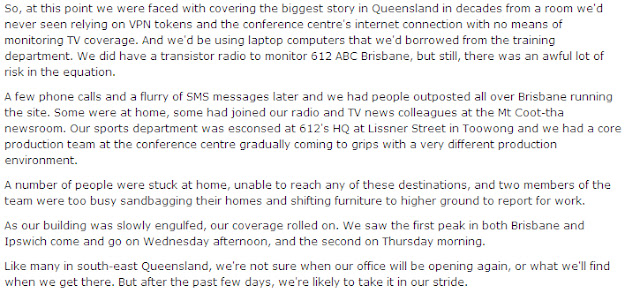OJ1#7
Online Journalism is never more important than when it is used to inform people all over the world of disasters. Live streaming allows for concerned citizens to be kept updated on crucial and critical information. Floods, tsunamis, cyclones and fires. Terrorist attacks, protests and killings. When tragedies occur, people turn to the internet for the most up-to-date and immediate information.
In Australia, the January floods were a testing time for Queensland and northern New South Wales, with the area inundated and lives lost. Reporters in the region were suddenly overwhelmed by not only the need to deliver up to date information and important facts, but many experienced the flooding first hand.
Melbourne ABC journalist, Will Ockenden , was flown in to help cover the Queensland floods in rural Queensland and was unexpectedly caught up in the middle of the Toowoomba flash flood disaster. His story here: http://www.abc.net.au/local/stories/2011/01/11/3110327.htm
The ABC radio building in the Brisbane suburb of Toowong, was surrounded by floodwaters and much of the important flood information for the region was broadcast from their Gold coast studio. ABC online In Milton, Brisbane, was also very affected by flooding, with their main building inundated by water and with some reporters being unable to leave their homes.
Read ABC reporters full account here: http://blogs.abc.net.au/newseditors/2011/01/from-newsroom-to-lounge-room.html
Social media updates by government organisations also play a key role in disaster management in Australia. Journalists refer the public to the Bureau of meteorology for precise local weather information, quote the relevant police media social networking updates and add vital emergency information media releases elements to their stories.


No comments:
Post a Comment
Note: Only a member of this blog may post a comment.